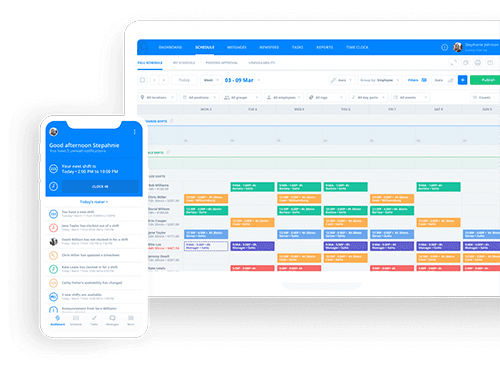Human Resource Planning: Definition, Objectives, And Steps
Human resource planning is an essential part of every successful business. Unfor...

Regardless of the type of business you run or the size of the team you supervise, a human resource management system can help you keep everything running smoothly and your organization on the road to success.
In this article, we discuss what goes into putting together a human resource management system (or HRMS for short) that has the potential to bring benefits to every corner of your operation.

A human resource management system goes by many different names, including:
Regardless of which term you use, an HRMS is a software application that combines a number of systems and processes used primarily to:
Incorporating an HRMS into your standard operating procedures can make it easier to access, manage, and otherwise streamline the everyday HR processes that keep your business running smoothly.
Many managers wonder, “Is there a difference between a human resource management system (HRMS) and a human resource information system (HRIS)?”
There is not. An HRMS and an HRIS are, essentially, the same thing under different names.
In fact, the term HRIS precedes the term HRMS by several decades and stems from the IT departments of the 1980s that used a set of tools commonly called Management Information Systems (MIS).
As those computer systems evolved, and HR information and processes went digital, it gave birth to a hybrid of the earlier management information systems geared especially toward the recordkeeping aspect of human resources.
That hybrid was HRIS.
In the early 2000s, human resources — and the technologies they used — expanded beyond just keeping records into recording a wide variety of employee data and automating the processes that employees use every day.
It’s at this point that HRIS transitioned from a basic information system that stored data to a more advanced management system (HRMS) that made organizing and optimizing workflow easier than ever.

Managing the human component of your business requires a lot of time, energy, and capital. In fact, it’s often one of the largest expenses that many organizations face on a daily basis.
Without adequate controls in place, that expense can spiral out of control and may affect your bottom line for the worse.
That’s where a human resource management system comes in.
Such systems can help you administer everything your team does — and all the systems that support them — more accurately and efficiently.
For example, many HRMSs offer self-service capabilities, such as access to time cards, team schedules, task lists, and even essential forms, like the W-4, W-2, and others. They can also help you stay compliant with government mandates, such as overtime and healthcare.
And, with more advanced control over those and other HR processes, your business may be better positioned to save money, grow, and improve the way it works.

Some HRM systems offer help with various aspects of the onboarding process, including many of the activities leading up to a new employee’s first day.
Bringing a new team member on board can be a long and costly process, but with an HRMS in place, you may be better equipped to manage résumés, coordinate interview schedules, and make the new hire feel as welcome as possible.
Employee management is the core of HRM system software and gives you the ability to:
And that’s just the tip of the iceberg.
In many ways, this is where a human resource management system really shines — helping you manage your employees better.
Employees who are more engaged tend to be more in line with the business’s vision, produce higher-quality work, integrate better with the company culture, and connect more readily with leadership and coworkers.
HRMS can help cultivate the employee engagement that leads to a better team and a better business.
With the help of an integrated HRMS, your business may be better positioned to conduct advanced activities such as:
With features such as these, your business can continue to develop its workforce and improve its overall operations.

Perfecting the way your team works goes a long way toward improving efficiency, productivity, and the overall happiness that they experience on a daily basis.
Some HRMS apps include components that make such optimization possible and give you more control over the way your team operates.
As an integrated system, HRM and workforce optimization allow you to balance a number of other critical variables within your business, including:
When these factors align, your business will likely run smoother, your team may be more efficient and effective, and you’ll be better able to scale your operation (up or down) to manage the demands of your customers.
Payroll is another primary function of most human resource management systems. With help from such software, your HR department may be better able to:
Some advanced HRM systems even allow you to give your employees self-service options, such as changing elective deductions, switching direct deposit accounts, customizing tax withholdings, and retrieving copies of earning statements.
Some HRMSs also allow you to administer your business’s benefits program from within the software. If you offer benefits — fringe or otherwise — you know how complicated things can get.
Especially if your business offers bonuses such as:
Even just one of these benefits — e.g., paid time off — can require countless hours to coordinate, track, and administer. Add another benefit (or two or three), and you’ve got a complicated process that can be a full-time job in itself.
An integrated HRMS can make things easier.
As we discussed earlier, recordkeeping is the foundation of all human resource management systems — that was their purpose back when they were called HRIS.
Even though the software now includes other, more advanced components, recordkeeping is still a big part of what HR software does.
The recordkeeping features in modern software allow you to transition to digital files and, in the process, to free up valuable physical space for other activities.
An HRMS then provides a single resource through which your HR team can store, update, and maintain the myriad records they need to do their job. With that centralization comes better reporting, lower costs, and improved workflow throughout the business.

Regardless of the size and type of business you run, or the number of employees on your payroll, a human resource management system, such as Sling, can help HR — and everyone on your team — do their jobs better.
The Sling app includes such tools as:
Try the Sling human resource management system for free to discover all the ways it may be able to help streamline your team’s activities and take your business to the next level.
For more free resources to help you manage your business better, organize and schedule your team, and track and calculate labor costs, visit GetSling.com today.
See Here For Last Updated Dates: Link
This content is for informational purposes and is not intended as legal, tax, HR or any other professional advice. Please contact an attorney or other professional for specific advice.
Schedule faster, communicate better, get things done.